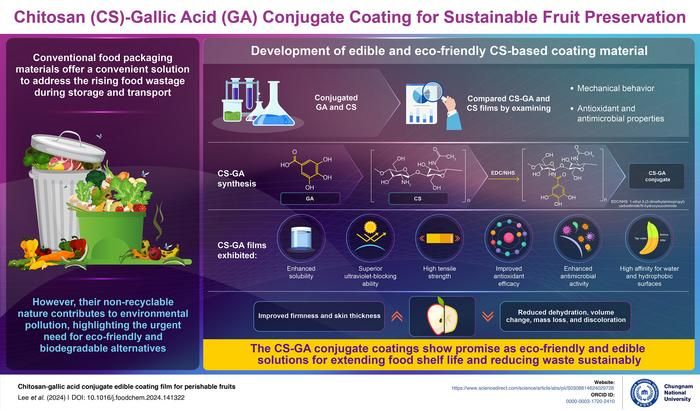Researchers develop an edible biofilm for extending fruit shelf life
The developed natural polysaccharide-based edible coating can replace synthetic packaging, offering a sustainable solution to reduce global food waste
With significant improvements in transportation technology, the accessibility of fresh food has considerably increased. However, this progress has been accompanied by escalating concerns about food waste during transportation and storage. Globally, around 17% of food at the retail and consumer levels is wasted, resulting in issues like groundwater contamination, hazardous gas emissions, and the spread of infectious pathogens, all contributing to environmental pollution. In a bid to develop efficient, cost-effective, and eco-friendly food preservation technologies, researchers across the world are studying alternatives for the development of packaging materials. Among these, edible coatings made of naturally occurring polymers have shown particular promise.

An innovative experimental study by a team of scientists from Chungnam National University, Korea shows how a chitosan and gallic acid conjugate can be used as an eco-friendly and non-toxic food coating material to extend the shelf life of perishable fruits.
Professor Won Ho Park from Chungnam National University, South Korea
These protective coatings can protect fruits from post-harvest degradation by preventing water loss and gas exchange, reducing the need for refrigeration or synthetic preservation, while extending shelf life.
Chitin, a natural polymer derived from the crustacean endoskeleton, is chemically modified to produce chitosan (CS). CS is non-toxic, biodegradable, and has remarkable film-forming abilities. However, certain limitations, including weak barrier and low antimicrobial properties, hinder its potential as a food coating material. To address this limitation, a team of scientists, led by Professor Won Ho Park from Chungnam National University, South Korea, incorporated a polyphenolic compound, gallic acid (GA), to produce a CS-GA conjugate. GA is abundantly available in plants and is well known for its excellent antimicrobial and antioxidant properties.
Elaborating further about their study, Prof. Park says, “We wanted to develop a CS-based biofilm with enhanced food coating properties, and we were hopeful that the incorporation of GA might help in achieving that.” This paper was made available online on September 16, 2024, and will be published in Volume 463 Issue 2 of Food Chemistry on January 15, 2025. In this study, the team reports the synthesis and characterization of a CS-GA conjugate film. They compared it with CS films to assess GA’s enhancement effects and tested its efficacy on stored mini bananas and cherry tomatoes.
They observed that the developed film exhibited enhanced mechanical strength, offering protection against food damage during transportation, and improved antioxidant properties, leading to extended shelf life. It also showed improved antibacterial activity against two types of bacteria, confirming its effectiveness against multiple microbial species and superior UV-blocking capabilities to prevent photo-discoloration and damage. Explaining the findings of the storage test. Prof. Park says, “Many consumers are concerned about remaining coating residues on the fruits. The washability of this conjugate makes it appealing for these consumers. Also, we observed a significant reduction in dehydration, discoloration, and mass loss of the stored fruits when the coating was applied. This indicates shelf life extension and freshness retention.”
Going ahead, this green technology could play a significant role in reducing food waste and also contribute to the United Nations' Sustainability Development Goals of halving the food waste by 2030. Sharing his concluding thoughts, Prof. Park says, “In the past, the primary strategy for addressing food waste reduction-related issues was to gather and dispose off food scraps. However, our research suggests that by enhancing food preservation capabilities using eco-friendly approaches, we may significantly reduce food waste occurring during the distribution process.”
Original publication
Most read news
Other news from the department science

Get the food & beverage industry in your inbox
By submitting this form you agree that LUMITOS AG will send you the newsletter(s) selected above by email. Your data will not be passed on to third parties. Your data will be stored and processed in accordance with our data protection regulations. LUMITOS may contact you by email for the purpose of advertising or market and opinion surveys. You can revoke your consent at any time without giving reasons to LUMITOS AG, Ernst-Augustin-Str. 2, 12489 Berlin, Germany or by e-mail at revoke@lumitos.com with effect for the future. In addition, each email contains a link to unsubscribe from the corresponding newsletter.






























































